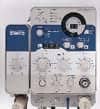Recent genetic discoveries are paving the way for groundbreaking treatments.
Cystic fibrosis (CF) is the most common life-threatening genetic disease in the United States, occurring in roughly one in 3,500 live births.1 Historically considered a pediatric disease, the average life expectancy of CF patients has tripled since 1960, with the median survival age now being 31 years, says Stanley B. Fiel, MD, FCCP, Professor of Medicine and Chief of Pulmonary and Critical Care Medicine at Allegheny University Hospitals, MCPuHahnemann School of Medicine, Philadelphia. Currently, 34 percent of patients treated by CF centers in the United States are 18 years of age or older, he says.
Recent groundbreaking discoveries could lead to an even greater shift in the median survival age, enabling average CF patients to live well into their sixties, Fiel says. Some experts believe that very promising research currently being conducted may one day yield a cure.
DIAGNOSIS OF CF
About 30,000 individuals in the United States have CF, with roughly 1,000 new cases diagnosed each year.2 CF is more predominant among Caucasians, affecting one in every 2,500 to 3,000 whites.3 One in 17,000 African Americans and one in 90,000 Asians have the disease.3 CF is characterized by the production of abnormally viscous mucus that interferes with normal organ function, including the pancreatic ducts, preventing normal digestion and leading to malabsorption and malnutrition. In 90Eses, the airways are affected, and most CF deaths result from devastating lung damage, Fiel says. The diagnosis of CF can be confirmed in a patient who meets any one of the following three criteria:4 1) the presence of one or more characteristic phenotypic features, a history of CF in a sibling or a positive newborn screening test, plus laboratory evidence of a cystic fibrosis transmembrane conductance regulator (CFTR) abnormality as documented by elevated sweat chloride concentrations; or 2) identification of two CF mutations; or 3) in vivo demonstration of characteristic abnormalities in ion transport across the nasal epithelium.
Recurrent or persistent pneumonias, pansinusitis, bronchiectasis, pancreatitis, and infertility in patients, and, more commonly among children, gastrointestinal symptoms such as voluminous, foul-smelling stools, failure to thrive, distal intestinal obstruction, rectal prolapse, unexplained cirrhosis, and vitamin deficiencies are all suggestive of CF,” Fiel says.
PATHOGENESIS OF CF LUNG DISEASE
All patients with CF have mutations in both copies of the gene on chromosome 7 that encodes a cAMP-regulated chloride channel called the CFTR. This mutation results in defective chloride transport in the epithelia of the lungs, gastrointestinal tract, and sweat glands3 (Figure 1). In individuals with CF, the manufacture and/or trafficking of CFTR proteins is defective, compromising the function of this protein, which is responsible for transporting electrolytes and water across membranes and maintaining normal mucus viscoelasticity.5 In regulating the movement of electrolytes across epithelial membranes, normal CFTR maintains the appropriate balance of intracellular and extracellular fluids.5 Abnormalities or defects in CFTR reduce the water content of mucus and may alter the ionic composition of airway surface fluids, resulting in the accumulation of viscous secretions. These thickened secretions are thought to prevent clearance of microorganisms from the respiratory tract, paving the way for self-sustaining infection and inflammation.3 Precisely how CF electrolyte transport defects give rise to persistent lung infection and inflammation is not well understood. Some research reveals the possibility of inflammation without infection or the presence of excessive inflammation following even a minor infection.3 Whether the inflammatory response is initiated at slight provocation or, when once initiated, the response fails to be regulated properly is an important area of research for investigators interested in understanding the pathology of CF lung disease and managing patients.3
GENE THERAPY
Treatment of CF has traditionally focused on symptomatic management (Figure 2). Current therapies involve the administration of antibiotics (oral, intravenous, and inhaled); chest physiotherapy for bronchial drainage; aerosol administration of agents to break up or thin viscous secretions (ie, recombinant human DNase); nonsteroidal anti-inflammatory drugs; oral pancreatic enzymes that aid digestion; exercise; and dietary management including nutritional supplements.6 Lung transplantation also has been performed in individuals with CF, but obtaining suitable donors can be problematic. Additionally troublesome are survival rates: 566for 3 years and 484for 5 years.7 Furthermore, not all CF patients are appropriate candidates for transplant due to infection with Burkholderia cepacia.
Since 1989, when a group of US and Canadian scientists cloned and sequenced the gene responsible for CF, an intensive effort has been under way to develop gene therapy for the disease. Researchers believe gene therapy, which will address the etiology of the disease rather than simply treating its symptoms, may be the best hope for a lifesaving treatment for CF. Furthermore, because CF occurs due to a defect in a single gene, this disease is a particularly good candidate for gene therapy research. Even small amounts of functional CFTR are sufficient to protect the lung against disease, and only a small proportion of the cells need to express CFTR for correction of the chloride transport properties.3
“At a conceptual level, the simplest and best corrective action would be to replace the faulty gene via gene therapy,” Fiel says. An intensive effort is under way to develop a viral or plasmid delivery system, or vector, that would deposit healthy genes directly into the damaged CF airway cells. Several vectors are being researched in an attempt to develop a mechanism that can deliver a functional CFTR gene. Currently, these include adenoviral (Ad) and adeno-associated viral (AAV) vectors. Scientists are assessing the safety and feasibility of these various gene delivery systems, and how often treatment will have to be repeated to be effective.
Although Ad and AAV vectors have shown promise in delivering genes to the target cells, the current vector systems being employed elicit a cytotoxic T-cell-mediated immune response associated with transient lung inflammation, Fiel says. Efforts to avoid this problem with recombinant AAV or plasmid vectors have yielded mixed results. “Genetic engineers are working on devising a better vector system that will not stimulate an immune response,” Fiel says. Some recent research efforts have been directed at the study of coated replication-deficient adenoviruses to devise a vector that can penetrate the airway epithelia without immune system recognition.
RESULTS OF GENE THERAPY RESEARCH
The Cystic Fibrosis Foundation (CFF) is funding five phase I trials of these new agents to determine their safety, efficacy, and appropriate dosing regimens.8
The first human trial of gene therapy for CF patients was initiated in 1993,6 and more than 100 US CF patients have undergone experimental gene therapy. Today, nine gene therapy research studies funded by the CFF also are under way.
Six of these studies are investigating the use of Ad vector systems to deliver therapy-either intranasally or via bronchoscope-directly to the airway epithelia. In phase I trials, the safety and effectiveness of this Ad viral vector system were monitored to determine if the normal CF gene was “switched on” to produce functional CFTR, vital to the health of cells lining the respiratory tract.8
Unfortunately, many researchers found that the Ad vectors elicited an immune response in subjects, reports John Wagner, MD, PhD, a principal researcher at Stanford University School of Medicine, in Stanford, Calif. In an attempt to circumvent this immune response, another study is examining aerosolized, liposome-encapsuled genes as a potential tool for targeted delivery of gene therapy.
Early data suggested that “liposomes were [thought to be] much safer, but it has turned out in the aerosol trial, some patients had flulike reactions to the large amount of DNA-liposome complexes needed for aerosolized treatment of the whole lung,” Wagner says. Future research efforts may involve new forms of chemically restructured liposomes capable of avoiding detection by the immune system.
Two other studies being conducted at Stanford University Medical Center are testing AAV systems in CF patients. In the phase I trial, evidence of successful AAV gene transfer was confirmed by scientists who were able to show that the transduced gene remained viable for up to 70 days. AAV gene therapy was well tolerated, no adverse events were recorded, and no neutralizing effects on immune response were observed, even after repeat delivery.8 “Our phase I trial showed that gene transfer occurred at a fairly high amount,” Wagner says. “More than 10 of cells exhibited gene transfer.” This volume of gene transfer can be sufficient to normalize the intracellular electrolyte fluid balance.
Stanford scientists are now conducting a phase II trial to assess the impact of gene therapy on sinusitis. “We use the sinus because it has a very similar disease process to [that of] the lung,” Wagner explains. “The supposition is that if the gene therapy helps the clinical disease in the sinus, then it’s likely to help the clinical disease in the lung as well.” Study results should be available later this year, and if the results show promise, the next step would be to conduct phase I aerosol trials of the AAV gene therapy to the lungs, Wagner says.
GENE-ASSIST THERAPY
Another potential therapeutic approach focuses on the abnormal gene product, CFTR. To regulate chloride ion secretion, CFTR needs to traverse the cytoplasm and be properly positioned within the cell membrane lining the airways, a process known as trafficking.9 CF gene mutations cause two functional defects, one that results in most CFTR being destroyed before it reaches the proper cell membrane location, and the second that impairs functionality of CFTR that reaches the membrane, preventing chloride ion transport to the airways.9
Researchers are exploring several drugs that appear to “repair” defective CFTR protein.8 Trials of the drug phenylbutyrate suggest that partial correction of chloride ion transport to the nasal tissues may be possible, while the drug CPX (8-cyclopentyl-1,3-dipropylxanthine) has been shown to interact directly with the 3F508 mutant CFTR to promote chloride ion transport, improving CFTR trafficking.10 Another investigational agent, UTP (uridine phosphatidylglycerol), bypasses the cellular defect and opens an alternate chloride channel. Normalizing chloride concentrations in the airway surface fluids, by whatever means, could improve the activity of endogenous antimicrobial substances that protect against infection.8
CONCLUSION
Today, RCPs can offer the parents of a newborn with CF a message of hope. By the early 21st century, median survival, theoretically, could be into the sixth decade of life,” Fiel says. “Taking a more conservative approach and extrapolating from the progress made in the last few years, we should shortly anticipate expanding median survival of CF patients into their forties,” Fiel says. “Clearly CF has made the turn from a morbid pediatric disease to a disease that allows hope in every sphere.”
Sally Lane is senior editor of RT.
Acknowledgement
The author would like to thank Stanley B. Fiel, MD, FCCP, article consultant, for assistance in preparing this manuscript.
REFERENCES
- Schultz D. Lung Disease Data. New York: American Lung Association; 1997:35.
- Gene Therapy and CF Fact Sheet. Bethesda, Md: Cystic Fibrosis Foundation; 1998.
- Davis PB, Drumm M, Konstan MW. State of the art: cystic fibrosis. Am J Respir Crit Care Med. 1996;154:1229-1256..
- Clinical Practice Guidelines for Cystic Fibrosis Committee. The diagnosis of cystic fibrosis: consensus statement. In: Clinical Practice Guidelines for Cystic Fibrosis. Bethesda, Md: Cystic Fibrosis Foundation; 1997:Appendix 1.
- Fiel SB. Discoveries in CF provide blueprints for a new generation of therapies. ACCP Symposia Highlights (62nd Annual International Scientific Assembly of the ACCP; San Francisco, Calif). Northbrook, IL: American College of Chest Physicians; 1996:13-16.
- Korst RJ, Noel MG, Chin-Shyan C, et al. Gene therapy for the respiratory manifestations of cystic fibrosis. Am J Respir Crit Care Med. 1995;151:S75-S87.
- Yankaskas JR, Mallory GB Jr. Lung transplantation in cystic fibrosis: consensus conference statement. Chest. 1998;113:21.
- Visiting the CF drug development pipeline: what is going in and what is coming out? Commitment. Bethesda, Md: Cystic Fibrosis Foundation; January 1998.
- Presented at the 11th Annual North American Cystic Fibrosis Conference; October 25, 1997; Nashville, Tenn.
- Weatherly MR. Medical topic: CPX: a new “gene-assist” drug. IACFA. 1997;51:3-5.
—









